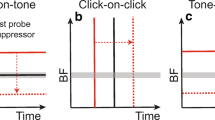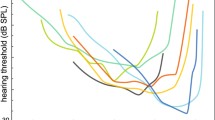Abstract
Frequency analysis by the mammalian cochlea is traditionally thought to occur via a hydrodynamically coupled ‘travelling wave’ along the basilar membrane. A persistent difficulty with this picture is how sharp tuning can emerge. This paper proposes, and models, a supplementary or alternative mechanism: it supposes that the cochlea analyses sound by setting up standing waves between parallel rows of outer hair cells. In this scheme, multiple cells mutually interact through positive feedback of wave-borne energy. Analytical modelling and numerical evaluation presented here demonstrate that this can provide narrow-band frequency analysis. Graded cochlear tuning will then rely on the distance between rows becoming greater as distance from the base increases (as exhibited by the actual cochlea) and on the wave’s phase velocity becoming slower. In effect, tuning is now a case of varying the feedback delay between the rows, and a prime candidate for a wave exhibiting suitably graded phase velocity—a short-wavelength ‘squirting wave’—is identified and used in the modelling. In this way, resonance between rows could supply both amplification and high Q, characteristics underlying the ‘cochlear amplifier’—the device whose action has long been evident to auditory science but whose anatomical basis and mode of operation are still obscure.
Similar content being viewed by others
References
Abnet CC, Freeman DM (2000) Deformations of the isolated mouse tectorial membrane produced by oscillatory forces. Hear Res 144:29–46
Bell A (2003) Are outer hair cells pressure sensors? Basis of a SAW model of the cochlear amplifier. In: Gummer AW (ed) Biophysics of the Cochlea: from Molecules to Models. World Scientific, Singapore, pp 429–431
Bell A (2004) Hearing: travelling wave or resonance? PLoS Biol 2:e337
Bell A (2005) The underwater piano: a resonance theory of cochlear mechanics. PhD thesis, Australian National University, Canberra
Bell A (2006a) Short-wavelength interactions between OHCs: a “squirting” wave model of the cochlear amplifier. In: Nuttall AL (ed) Auditory Mechanisms: Processes and Models. World Scientific, Singapore, pp 496–497
Bell A (2006b) Sensors, motors, and tuning in the cochlea: interacting cells could form a surface acoustic wave resonator. Bioinsp Biomim 1:96–101
Bell A (2007) Detection without deflection? A hypothesis for direct sensing of sound pressure by hair cells. J Biosci 32 (in press)
Bell A, Fletcher NH (2004) The cochlear amplifier as a standing wave: “squirting” waves between rows of outer hair cells? J Acoust Soc Am 116:1016–1024
Brownell WE, Bader CR, Bertrand D, de Ribaupierre Y (1985) Evoked mechanical responses of isolated cochlear outer hair cells. Science 227:194–196
Campbell CK (1998) Surface Acoustic Wave Devices for Mobile and Wireless Communications. Academic, San Diego
Counter SA, Borg E, Lofquist L (1991) Acoustic trauma in extracranial magnetic brain stimulation. Electroencephalogr Clin Neurophysiol 78:173–184
Davis H (1983) An active process in cochlear mechanics. Hear Res 9:79–90
Drexl M, Henke J, Kössl M (2004) Isoflurane increases amplitude and incidence of evoked and spontaneous otoacoustic emissions. Hear Res 194:135–142
Elliott SJ, Pierzycki R, Lineton B (2005) Incorporation of an active feedback loop into the “squirting wave” model of the cochlear amplifier. In: Proceedings of the 12th international congress on sound and vibration, Lisbon, Portugal
Evans BN, Hallworth R, Dallos P (1991) Outer hair cell electromotility: the sensitivity and vulnerability of the DC component. Hear Res 52:288–304
Frank G, Hemmert W, Gummer AW (1999) Limiting dynamics of high-frequency electromechanical transduction of outer hair cells. Proc Natl Acad Sci USA 96:4420–4425
Gold T (1948) Hearing. II. The physical basis of the action of the cochlea. Proc R Soc Lond B 135:492–498
Gold T (1987) The theory of hearing. In: Messel H (ed) Highlights in science. Pergamon, Sydney, pp 149–157
Guinan JJ, Lin T, Cheng H (2005) Medial-olivocochlear-efferent inhibition of the first peak of auditory-nerve responses: evidence for a new motion within the cochlea. J Acoust Soc Am 118:2421–2433
Hassan W, Nagy PB (1997) On the low-frequency oscillation of a fluid layer between two elastic plates. J Acoust Soc Am 102:3343–3348
Kemp DT (1978) Stimulated acoustic emissions from within the human auditory system. J Acoust Soc Am 64:1386–1391
Lloyd P, Redwood M (1965) Wave propagation in a layered plate composed of two solids with perfect contact, slip, or a fluid layer at their interface. Acustica 16:224–232
Lonsbury-Martin BL, Martin GK, Probst R, Coats AC (1988) Spontaneous otoacoustic emissions in a nonhuman primate. II. Cochlear anatomy. Hear Res 33:69–94
Morse PM (1991) Vibration and Sound. Acoustical Society of America, New York
Nilsen KE, Russell IJ (1999) Timing of cochlear feedback: spatial and temporal representation of a tone across the basilar membrane. Nat Neurosci 2:642–648
Nuttall AL (ed) (2006) Discussion [various contributors]. In: Auditory Mechanisms: Processes and Models. World Scientific, Singapore, pp 519–543
Patuzzi RB (1996) Cochlear micromechanics and macromechanics. In: Dallos P, Popper AN, Fay R (eds) The Cochlea. Springer, Berlin Heidelberg New York, pp 186–257
Robinette MS, Glattke TJ (2002) Otoacoustic Emissions: Clinical Applications. Thieme, New York
Robles L, Ruggero MA (2001) Mechanics of the mammalian cochlea. Physiol Rev 81:1305–1352
Scherer MP, Gummer AW (2004) Vibration pattern of the organ of Corti up to 50 kHz: evidence for resonant electromechanical force. Proc Natl Acad Sci USA 101:17652–17657
Shera CA, Guinan JJ, Oxenham AJ (2002) Revised estimates of human cochlear tuning from otoacoustic and behavioral measurements. Proc Natl Acad Sci USA 99:3318–3323
Shera CA, Guinan JJ (2003) Stimulus-frequency-emission group delay: a test of coherent reflection filtering and a window on cochlear tuning. J Acoust Soc Am 113:2762–2772
Siegel JH, Cerka AJ, Recio-Spinoso A, Temchin AN, van Dijk P, Ruggero MA (2005) Delays of stimulus-frequency otoacoustic emissions and cochlear vibrations contradict the theory of coherent reflection filtering. J Acoust Soc Am 118:2434–2443
Slepecky NB (1996) Structure of the mammalian cochlea. In: Dallos P, Popper AN, Fay R (eds) The Cochlea. Springer, Berlin Heidelberg New York, pp 44–129
Tanaka Y, Asanuma A, Yanagisawa K (1980) Potentials of outer hair cells and their membrane properties in cationic environments. Hear Res 2:431–438
Ulfendahl M (1997) Mechanical responses of the mammalian cochlea. Prog Neurobiol 53:331–380
Zheng J, Shen W, He DZZ, Long KB, Madison LD, Dallos P (2000) Prestin is the motor protein of cochlear outer hair cells. Nature 405:149–155
Author information
Authors and Affiliations
Corresponding author
Rights and permissions
About this article
Cite this article
Bell, A. Tuning the cochlea: wave-mediated positive feedback between cells. Biol Cybern 96, 421–438 (2007). https://doi.org/10.1007/s00422-006-0134-0
Received:
Accepted:
Published:
Issue Date:
DOI: https://doi.org/10.1007/s00422-006-0134-0




